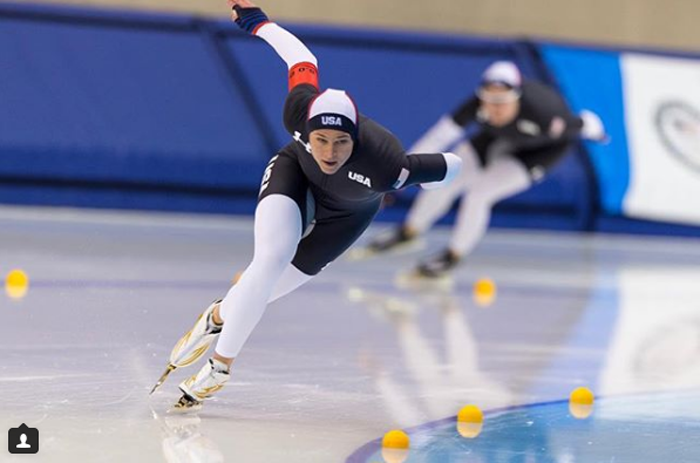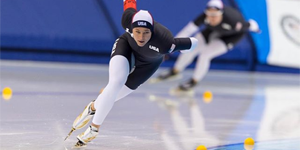Can Aerodynamic Suits Give U.S. Speed Skaters an Edge?
To achieve their best at this year's Winter Olympics in PyeongChang, speed skaters from all over the world have spent countless hours training on the ice and in the gym. American skaters are hoping that specially designed aerodynamic suits will give them an edge over their competition. Students can learn more about aerodynamics with hands-on STEM projects.

Speed Skating: The Fastest Human-powered Sport
In a sport where races are won by fractions of seconds, athletes train hard to hone their technique, but they also pay close attention to any equipment innovations that may increase their speed. In the late 1990s, athletes began using a controversial new type of skate, and world records fell at an unprecedented rate. More recently, teams have been focused on refining their body-hugging suits. But can a specialized suit really make a difference in a racer's time? To find the answer to that question, we need to talk about aerodynamics and drag.
Aerodynamics Basics
Aerodynamics is the study of how objects move through air. We often think of aerodynamics in relation to cars or airplanes. Drag, or air resistance, is a force that acts on an object opposite its direction of motion. Drag occurs because an object has to push air out of the way to move forward, and drag gets stronger the faster an object moves. Drag is why fast cars and airplanes are designed with sleek, low profiles: the less air they have to push out of the way, the more easily they can travel through the air, using less energy.
These same concepts apply to speed skaters as they race around their track. Imagine this: two speed skaters are racing, but one is holding a giant kite in front of their body. Which one would win the race? To move forward, the skater holding the giant kite would have to push much more air out of the way than the skater without the kite, so the skater without the kite would win. While this example is an exaggeration of what a sleek suit can do for a speed skater, it does demonstrate that less drag leads to increased speed.
Disappointment in 2014
In the lead up to the 2014 Winter Olympics, the U.S. Speedskating team had high hopes for a newly-designed skating suit called the "Mach 39." Among other innovations, special panels on the arms, legs, and head were intended to reduce the amount of drag experienced by a skater. U.S. skaters had done very well in World Cup races that fall, and they expected that this new suit would make them even faster. The suit, designed by Under Armour, had been tested extensively in wind tunnels, but had not been used by the skaters in competition.
Despite the suits, at the 2014 Olympics, the U.S. speed skaters found themselves watching other countries win medal after medal. What happened? Some people blamed the new suits, saying that perhaps an air vent in the back was creating drag. Some skaters switched back to wearing their old suits in hopes of changing their luck.
Going for the Gold in 2018
Between the 2014 and 2018 Olympics, US Speedskating carefully examined everything about their team—the training, the travelling, and the suits. The organization made many changes to their program and also reworked their approach to creating suits for their skaters. Instead of waiting until the last minute to give newly designed suits to the athletes, the organization worked closely with athletes throughout the process. This year's suits, which include a new aerodynamic fabric, were tested both by mannequins in wind tunnels and by real athletes on the ice.
Will the new suits help Team U.S.A. bring home the gold in the 2018 Winter Olympics?
Aerodynamics Science for Students
Principles of aerodynamics apply just about anywhere people and things are moving. For students who would like to learn more about aerodynamics, these Science Buddies Project Ideas provide further explorations of this fascinating field:
- The 'Ultimate' Science Fair Project: Frisbee Aerodynamics
- How Far Will It Fly? Build & Test Paper Planes with Different Drag
- The Wright Stuff: Using Kites to Study Aerodynamics
- The True Cost of a Bike Rack: Aerodynamics and Fuel Economy
- What A Drag!
- A Cure for Hooks and Slices? Asymmetric Dimple Patterns and Golf Ball Flight
- Parachutes: Does Size Matter?
- View more aerodynamics projects
The STEM Career Connection
Creating new equipment for elite athletes involves people with a variety of skills. Students interested in this story may want to investigate these STEM careers:
Update! For more information and related science and engineering projects and activities, see the Winter Olympics Science Experiments resource.
Categories:
You Might Also Enjoy These Related Posts:
- Plastics and Earth Day - Science Projects
- Arduino Science Projects and Physical Computing
- 10+ Robotics Projects with the BlueBot Kit
- 5 STEM Activities with Marshmallow Peeps
- March Madness Basketball Science Projects: Sports Science Experiments
- Women in STEM! More than 60 Scientists and Engineers for Women's History Month
- Explore Artificial Intelligence and Machine Learning with Student AI Projects
- 10 Reasons to Do the Rubber Band Car Engineering Challenge










